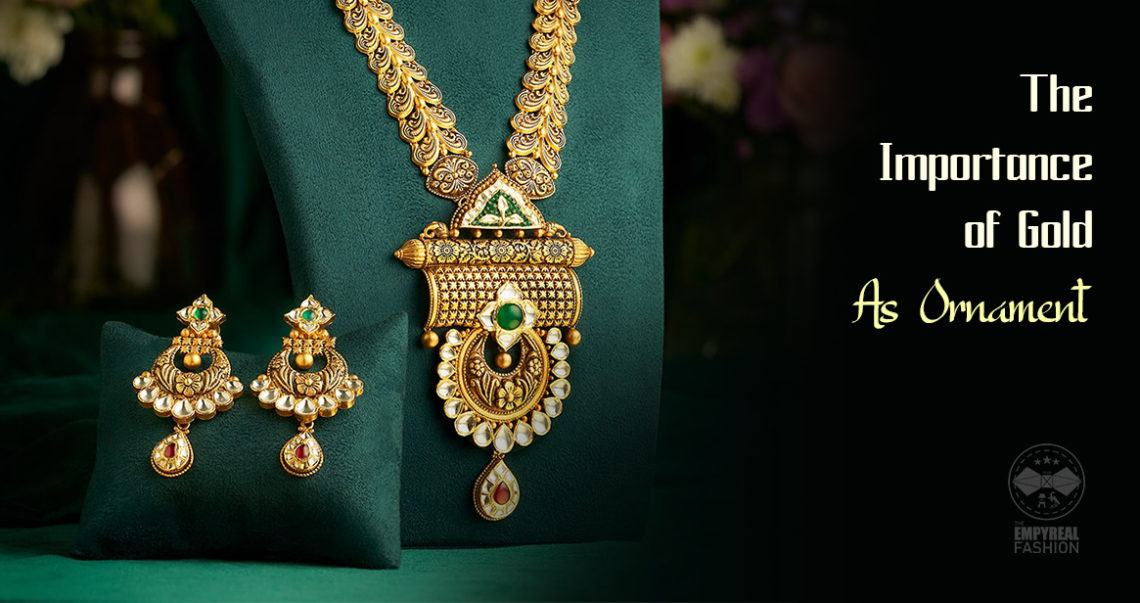
The Importance of Gold as Ornament
Since 2600 BC, gold has ruled the hearts and the souls of all human beings. From gracing the necks of the noble elite in the Egyptian era, to its usage in modern day cancer-alleviating medicine, it is clear that the element is held in high regard for its ability to make anything beautiful. But, why there is so much importance of Gold in the present day? Read on to find out more.
The Historical Significance of Gold:
Gold was first used within ornaments and jewellery by the ancient Mesopotamian in 2600 BC. The archaeologists have since discovered that gold was reserved for the most prestigious religious functions, and was commonly placed in royal treasuries and temples. It was also at this time that Gold was first used for personal ornaments, including fluted bowls and goblets. The aesthetic and decorative uses of Gold were also present in the Egyptian era – most famously when Tutankhamen’s tomb was found to be constructed primarily out of gold.
As centuries passed, gold began to be used for more practical, everyday items. In 564 BC, King Croesus of Lydia and his officials mastered how to improve the refinement of the element, resulting in the first gold currency the world had encountered. Whilst gold currency then circled for many years, it was not until 1717 that the United Kingdom established the ‘gold standard’, linking a value of 77 shillings to a piece of gold at mint price.
By this point in history, gold had become so coveted that many were willing to do whatever it took to get their hands on it. This was one of the driving factors behind the California Gold Rush of 1848 – 1855. When gold was found by James Marshall at Sutter’s Mill in California, 300,000 people rushed to the area to see if they could get their hands on the precious element. It’s clear to see why and how gold become so coveted throughout history, but how is it significant to certain cultures?
Gold in the Middle East:
One of the largest references for how gold is used in the Middle East is the Bible. In the book of Genesis, ‘the gold of the land’ is spoken about in great detail. Gold was also available in lots of different sizes and standards within the region. In particular, one ‘talent’ of gold was known to be the largest monetary standard in the Middle East. One ‘talent’ of gold weighed around 35 kilograms, which is worth $432, 132 USD in modern day. Centuries onward, the Egyptians discovered they could alloy gold to increase its strength and durability. They were also able to add colored pigments to the element, allowing them to create colorful, intricate sculptures that still exist today.
Currently, the Middle East is the largest purveyor of gold in the world, for both ornaments and jewellery. For example, Dubai is called ‘The City of Gold’ as it has become a major gold trading center since purchasing raw material from Ghana and selling the products to buyers elsewhere in the Middle East and South Asia. However, two thirds of gold jewellery purchased in the Middle East is used for savings, particularly in rural areas where the banking system has not yet become custom.
Gold in South Asia:
Gold has been a prominent part of South Asian culture for centuries. In the 1st millennium, the region was known by traders as ‘Survarnabhumi’ or the ‘Land of Gold’. Gold deposits in the area became one of the most important factors in early contact between India and China. Furthermore, 11th century Indian texts denotes that gold from the region could be separated into lots of different categories for different uses, with white gold being used more for jewellery, and yellow gold being used for ornaments. This belief has been taken through to the modern day, as many South Asians across the continent believe that gold is a sacred element, and is considered to be a sign of both power and wealth.
Gold in the Western World:
Gold has also played a key part in fashion and culture within the western world. Historically speaking, it has been used visually to represent the religious values of important European monarchs, including crowns, altars, reliquaries and bibles. Whilst some experts believe that we have hit ‘peak gold production’ over the past few decades, the demand for the precious element has only increased in the western world year after year.
This demand is demonstrated by the use of gold in everyday items, from gold-plated wristwatches to gold-rimmed spectacles. Furthermore, the recent trend of rose-gold items has become particularly popular in the western world, as seen in the rise of rose-gold jewellery particularly marketed towards women.
Can we stay ‘Golden’ Forever?
On a fundamental level, humanity has always and will always have an obsession with gold. But this, like all good things, comes with a price. Experts estimate that gold mining may reach the point of becoming economically unsustainable by 2050. However, there is always hope that new discoveries of gold will bring out new sources we currently have. For now, we should enjoy the history and legacy of such a beautiful material and not take it for granted.





